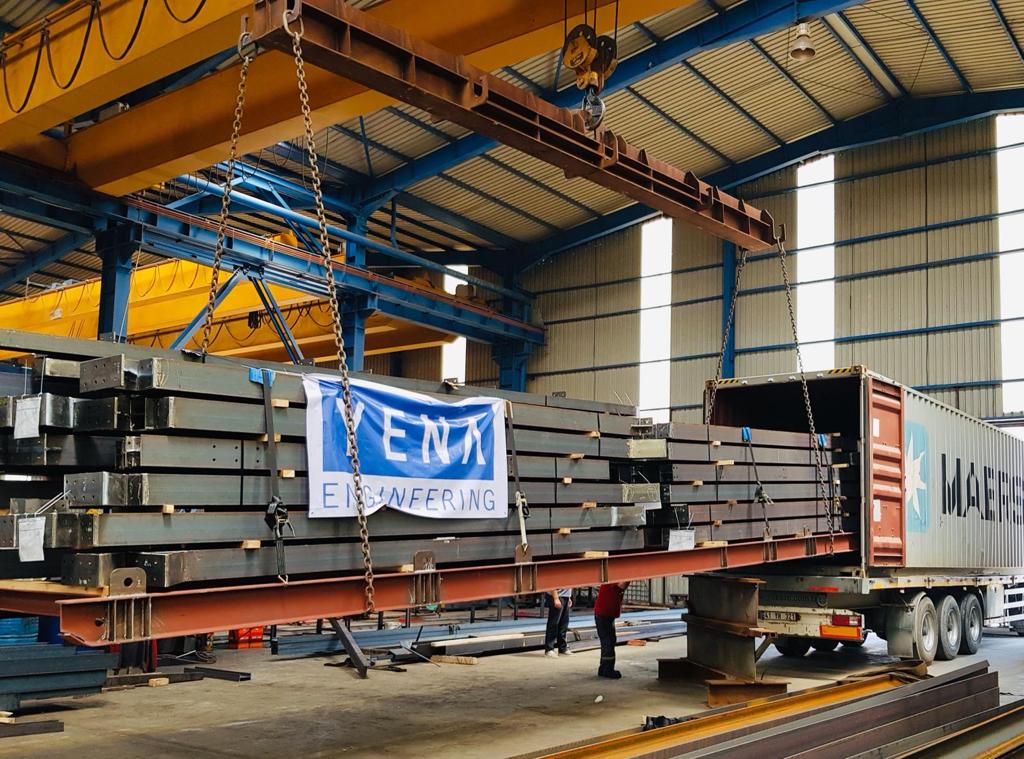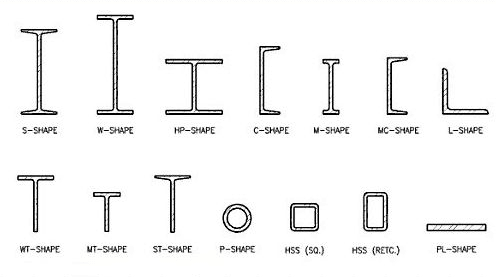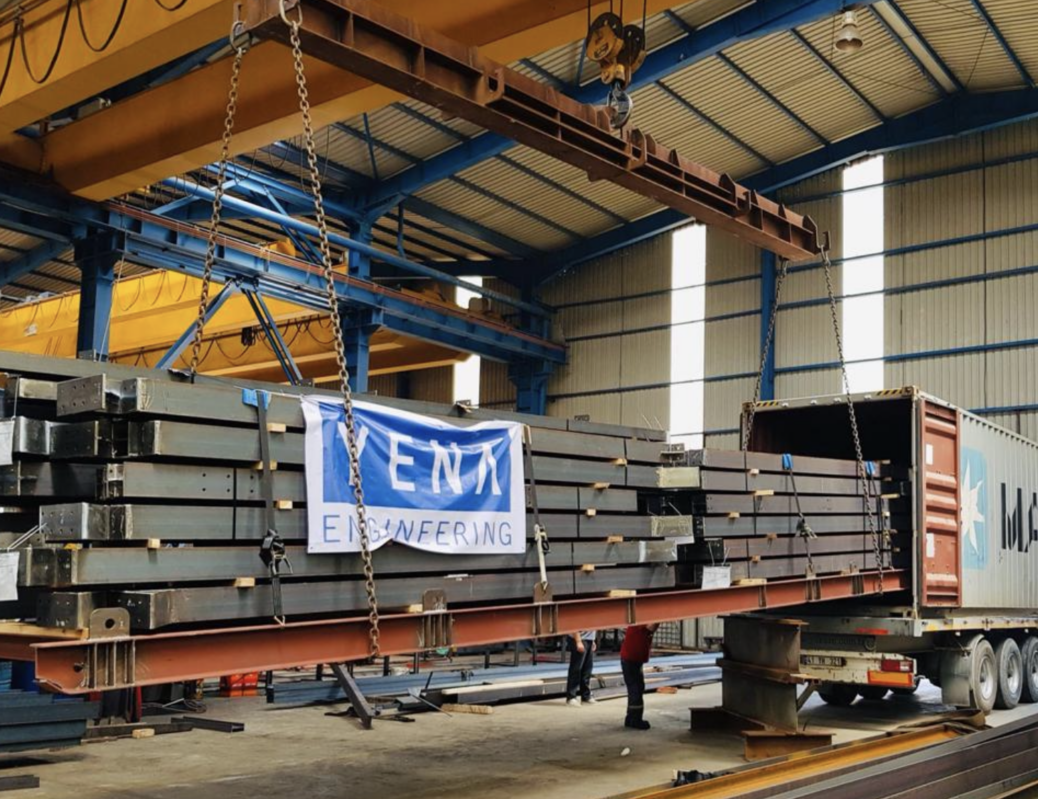In today’s world, we see and use steel structures everywhere. The existence of the railways we use every day from home to work, or one of the world’s most visited tourist attraction points Eiffel Tower, is made possible by the use of steel as a structural material. Thanks to its unique properties, all types of steel form a basis for our modern society. But what exactly is structural steel? What is the difference between mild and structural steel? Why and how do people use it? All of these questions and more will be thoroughly explained in this article.
1.) What is structural steel?
Structural steel is a type of steel that is used as a construction material. It is designed to have a good strength/weight ratio (which is also called specific strength) and to be cost-effective in order to be benefited as a structural component in buildings, roads, bridges, etc.

2.) Why steel? Steel as a robust material
Steel, one of the most essential materials of the modern world, comes in various different grades and shapes. It is simply an alloy of iron and a very low amount of carbon (up to 2.1% in weight). There also other elements sometimes. Due to its high tensile strength and low price, it is a significant component utilized in infrastructure, tools, ships, cars, machines, appliances, and buildings.
Steels are produced and used with various production methods by providing microstructure change by making necessary heat treatments according to the desired feature. In addition, alloy elements can be added to steel for having varying properties. Phase diagrams are particularly important in heat treatment.

Figure 1: Iron – Carbon Equilibrium Phase Diagram
3.) Structural Steel Types and Grades
There is not just one type of structural steel. There exist various different shapes and grades, depending on the needs for that specific application. Structural steels are classified by the shape of their cross-sections, such as the most frequently used I, T, C shapes (2). Besides their shape, the grade of the steel directly affects the mechanical properties. So, different grades of structural steel must be chosen according to different design requirements.
Several types of steel can be shaped and used as beams, rods, plates, bars, or profiles. Here are the standard structural steel materials:
Carbon Steels:
Steel can be defined as carbon steel when the addition of any other alloying element (such as tungsten, zirconium, cobalt, nickel, etc.) is not required, copper content does not exceed 0.4% or the following elements does not exceed indicated percentages in weight (Mn: 1.6%, Si: 0.6%, Cu: 0.6%) (3). Carbon steels are generally categorized by their carbon content as low-carbon (< 0.3%), medium-carbon (0.3-0.6%), high carbon (0.6-1%) and ultrahigh carbon (1.25-2%) steels. It is mostly used in structural pipe and tubing.
High Strength Low Alloy Steels:
This kind of steels is designed to have better mechanical properties and be more resistant to atmospheric corrosion than carbon steels. They contain manganese up to 2.0%. Small portions of other alloying elements such as chromium, nickel, molybdenum, nitrogen, vanadium, niobium, and titanium can be used in different combinations to alter the properties (3). Weathering steels which are a sub-type of high strength low alloy steels, have high resistance against atmospheric corrosion by forming a passive, rust-like layer on the surface, being one of the important structural steels. Mostly used in structural shapes and plates.
Forged Steels:
Forging is simply the process of shaping the metal while it is in the solid-state. It is done by applying mechanical and thermal energy to steel ingots or billets. This process introduces a uniform grain structure to the material, which decreases discontinuity in the matrix by removing voids, gas bubbles and increases overall strength (4).
Quenched and Tempered Alloy Steels:
A type of structural steel (for example A514) mostly used in building constructions. As it can be understood from its name, this type of steel has undergone quenching and tempering heat treatment steps.
4.) Common Structural Shape
The shapes of structural steels given in many standards worldwide. In short, angles, tolerances, dimensions, and cross-sectional measurements of steels are defined on standards, and these steels are named. Below figure 2 show the common structural shapes of steels. While many sections are formed by hot or cold rolling, others are made by welding together flat or bent plates.

Figure 2: The Various Types of Structural Steel Shapes
b.) ASTM
These steels have associate alloy identification beginning with A and then two, three, or four numbers. The four-number AISI steel grades usually used for mechanical engineering, machines, and vehicles are a totally different specification series. Special names have for all steels.
For Example:
A1085 – structural pipe and tubing
A36 – structural shapes and plate
5.) Advantages and Disadvantages of Structural Steels
| ADVANTAGES | DISADVANTAGES |
| High Strength to weight ratio | Susceptible to corrosion |
| Easy and high quantity production | High cost to make it corrosion resistant |
| Formed and molded | Fatigue |
| Cheap | Buckling |
| Long lived | Strength decrease in high temperatures |
Higher strength/weight ratio:
When compared, steel dominates every other conventional structural material such as stone, cement, or wood in terms of strength/weight ratio. It means that the tolerance against poor foundations is higher.
Good ductility:
Ductility is the ability of the material to withstand loads without failure. Thanks to the elastic nature of steel, it can return to its original shape after bending. Yielding up to some point prevents premature failures. Hard and brittle materials can fail suddenly, thus are not favourable.
High Toughness:
The ability of a material to absorb energy is called toughness. Structural steels have high toughness values; thus they are very suitable for construction applications. They are both strong and ductile. Also, it should be mentioned that the main difference between mild and structural steel is that structural steels are stiffer in order to carry higher loads without needless sagging.
Architectural variety:
Steel structures make so various different architectural designs possible. All around the world, astonishing steel buildings, towers, and bridges can be witnessed. One would be surprised to find out that this material was not economically reasonable to use as a structural component, just one hundred years ago.
Saving space:
In a comparison with reinforced concrete, a 40×40 cm2 steel carrier can do the same job as a 100×100 cm2 reinforced concrete carrier. This example shows that a net saving in terms of a usable area can be done (5).
There exist some drawbacks which can be solved with additional costs like corrosion and fire susceptibility, or the risk of buckling under heavy loads. Yet, major advantages may still outweigh these drawbacks in particular design applications.
6.) Structural Steels Applications
What comes to your mind when you hear the word structural steel? Hopefully, it’s not just construction. Structural Steel is that the most preferential metal by architects, designers, engineers, contractors, and fabricators. Due to properties especially highly durable, corrosion-resistant, tensile, and relatively low price has found used in various fields.
Construction
Structural steel has varied applications in the construction industry. It is generally used in designing and building industrial places. Structural steel has a high strength/weight ratio that makes it excellent to use in the construction of enormous structures such as buildings, warehouses, bridges, factories, etc. Steel frames, beams, columns, bars, girders, plates, and many others are created by structural steel fabricators which are used in the construction industry. Every year, about 25% of structural steels are used in the construction of buildings.
Mining
The mining industry has a lot of applications of structural steel. Most of the components in the mining substructure are reinforced using structural steel. All workshops, offices, structural parts of mines such as mining screens, fluidized bed boilers, buildings are made with structural steel. Structural steel is easy to clean because of its smooth surface. Therefore, do not interfere with other elements
Transportation
Structural steel is used to produce trucks, transmissions, trains, rails and ships, anchor chains, aircraft undercarriages, and jet engine components. Most of these vehicles contain a significant amount of structural steel. Structural steels used due to their elasticity, corrosion resistance, tensile strength, ductility, malleability, and affordability.
Marine
Most marine vehicles are built using structural steel, for example; submarines, boats, supertankers, ladders, steel flooring, and grating, stairs, and fabricated sections of steel. Structural steel can resist external pressures, can be formed easily. These properties make structural steels purposive for the marine sector.
Energy
There are a lot of structural steel applications in the energy industry. It is used in many industrial buildings in renewable and non-renewable energy sources such as transmission towers, pipelines, wind turbines, electromagnets, transformer cores, oil and gas wells.
7.) Standarts
Structural steel shapes, sizes, chemical composition, mechanical properties like strengths, storage practices are manufactured by standards. Structural steels are generally specified based on the appropriate industry or national standards, such as ASTM, API, BSI, ISO, etc. In most cases, standards give mainly the basic requirements such as limits on chemical composition and tensile properties.
The two most widespread standards of use are the European Standard (EN 10025) and the American Standard (ASTM).
a.) EN 10025
The names of structural steels begin with “S” and after writing “Yield Strength (in N/mm2). Then they may be designated, “Toughness Value”, ”Fine Grain or not ”, ”Tempered or Quenched”
For example : ‘S275J2′ or ‘S690QL’
8.) How to choose your manufacturer?
It can be troubling to decide on such an important matter. A wrong decision in the manufacturer can be costly. Our advice given below can be useful when choosing your manufacturer
Know what you are looking for.
Determine your priorities and expectations from your manufacturer before the interview with the candidates.
Take your time.
Rushing into a choice of the manufacturer may take more of your time than evaluating them. Test multiple companies if necessary and choose the best one for you.
Ask for background.
A company with a good history is less likely to let you down, best to keep that in mind.
Consider hiring agents
There are lots of invisible costs in the process of procurement. Hiring experienced professionals or companies for your procurement projects may cut your expenses substantially. Feel free to ask anything about this subject to Yena’s experienced team in various structural steel projects.
YENA Engineering is well experienced in steel construction projects like high rise buildings, roof systems, bridge parts, industrial buildings, and related construction equipment manufacturing. We are able to perform projects according to EN 1090-1 EXC2, EXC3, and EXC4. Our welding procedures are suitable with EN ISO 3834-2.
We offer a one-stop sourcing service for construction projects including shop drawings, raw material procurement, surface treatment (sandblasting, final painting), galvanizing, cutting, drilling, welding and finishing.
For detailed information about us check out our product page https://yenaengineering.nl/structural-steel-parts/
Our references https://yenaengineering.nl/references/
or feel free to contact us https://yenaengineering.nl/contact/
You May Be Interested:
- Minimum Radius for A Proper Bending
- 4 Latest Technologies in Steel Industry
- 6 Essential Questions Worth Asking to Your Structural Steel Provider
- Footbridges Manufacturing by Using Structural Steel
- Efficient Sustainable Building and Constructional Steel Production


